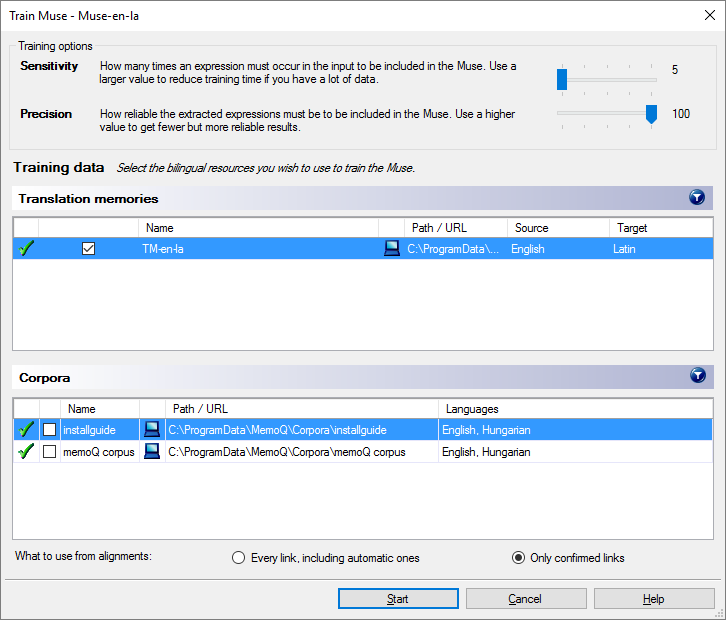Train Muse
A Muse is a resource – a statistical database – that offers hints for predictive typing in the translation editor.
A Muse guesses the next work or expression, computing from the source text and the translation that was already typed. In a way, the Muse is similar to a statistical machine translation module, but it can be more precise - because it does not have to guess an entire sentence, just the next few words.
A Muse is bilingual: In a project, you can use a Muse if it has the same language pair as your project.
You need to train a Muse after you create it, or when you choose to train it again. You should re-train a Muse if the translation memories and the LiveDocs corpora you used originally have a lot of new entries or documents - or you want to use more translation memories and LiveDocs corpora.
If the Muse is on a memoQ TMS: To train an online Muse, you must choose from translation memories and LiveDocs corpora on the same server. You cannot use your local translation memories or LiveDocs corpora. To use the contents of a local translation memory or LiveDocs corpus, you must share them on the server first.
How to get here
- Open the Resource Console. Choose Muses. Under the list, click Create new.
From a project: Open a project. In Project home, choose Muses. On the Muses ribbon, click Create/Use New. This command creates the Muse, and adds it to the project.
- Fill in the boxes in the Create Muse window, and click OK.
To learn more: See Help about the Create Muse window.
The Train Muse window opens automatically.
To re-train an existing Muse:
- Open a project where you use this Muse. It must be a local project or a checkout of an online project.
- In Project home, choose Muses.
- Right-click the name of the Muse. Choose Retrain.
The Train Muse window opens.

What can you do?
Use the two sliders under Training options:
- Sensitivity: Choose how many times a phrase must occur in the translation memories and LiveDocs corpora (together) to get into the Muse. Choose a value between 5 and 25. Normally, memoQ includes a phrase if it occurs 5 times or more.
- Precision: Choose how reliable the Muse should be. Choose a value between 0 and 100. A low value means that you will get a lot of hints (in predictive typing), but many of them may be wrong. A high value means that memoQ will suggest a phrase only if it is absolutely sure. In this case, you will not get a lot of suggestions.
Under Translation memories, select the checkbox of each translation memory that you want to use in the Muse. memoQ will read all translation units from the translation memory, and use them in the training of the Muse.
Under Corpora, select the checkbox of each LiveDocs corpus that you want to use in the Muse. memoQ will read all bilingual documents and document pairs from the LiveDocs corpra, and use them in the training of the muse.
A LiveDocs corpus may contain aligned document pairs. In the document pairs, there may be links that were not confirmed by a human user. You can choose whether or not you want to use these.
Use the radio buttons next to What to use from alignments:
- Every link, including automatic ones: To use the unconfirmed links, click this.
- Only confirmed links: Normally, memoQ uses confirmed links only.
If the Muse is on a memoQ TMS: To train an online Muse, you must choose from translation memories and LiveDocs corpora on the same server. You cannot use your local translation memories or LiveDocs corpora. To use the contents of a local translation memory or LiveDocs corpus, you must share them on the server first.
When you finish
To train the Muse, then return to Project home or to the Resource console: Click Start.
To return to Project home or to the Resource console without training the Muse: Click Cancel.
If you create a Muse, but you click Cancel in the Train Muse window, memoQ will create an empty Muse. To make it work, re-train it.